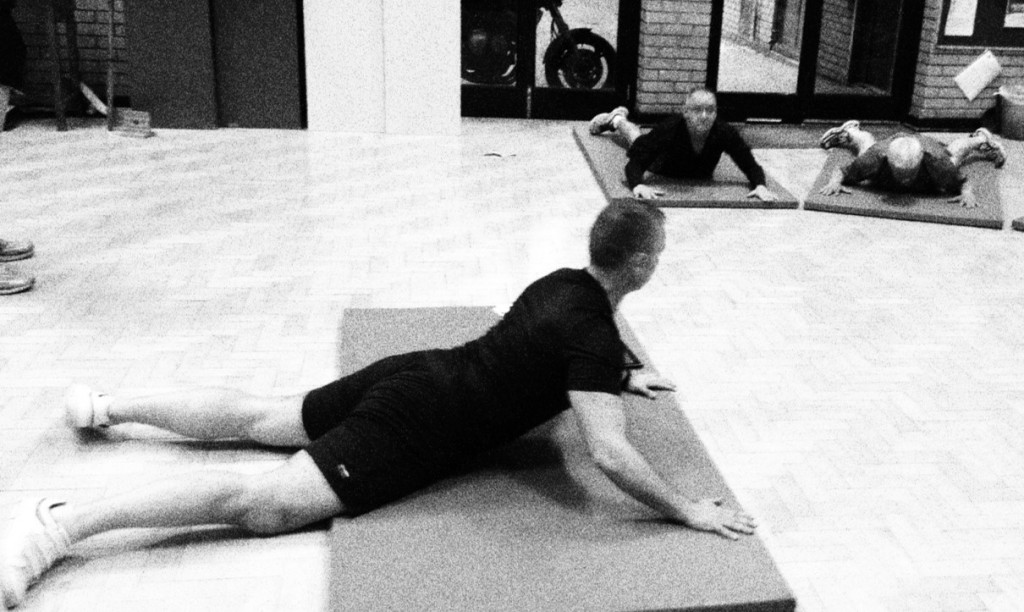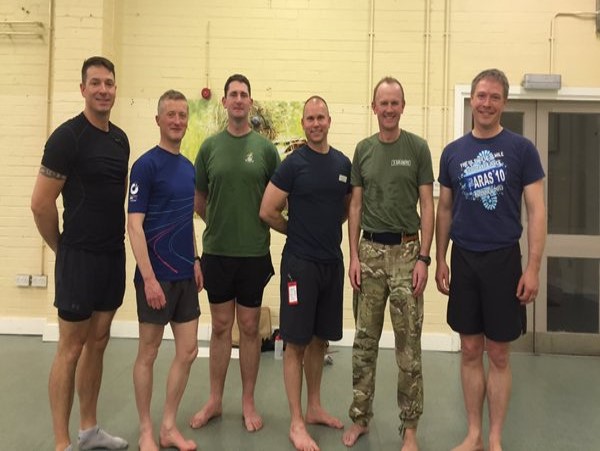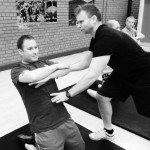Pilates for the Military – Drills That Get Results
by Joakim Valsinger
A Pilates studio is a long way from the military exercise ground and the daily tasks expected from military personnel seem very different than executing exercises on a Pilates mat or apparatus. But Pilates can improve the effectiveness of servicemen and women and there are some lessons from the military way of working which can enhance the Pilates experience.
As a participant of the Lolita San Miguel’s Pilates Master Mentor Program and a former paratrooper and Australian Army commando, Lolita inspired me to conduct research on Pilates for the military. Pilates has already been shown to be very successful in the rehabilitation of wounded soldiers in many programs worldwide. I wanted to assess the benefits of a structured Pilates program on “fit for duty” military personnel. This was a challenge because Drill Instructors want fit soldiers; they care little how grounded, relaxed, energized, positive, and supple a soldier feels. The military wants tangible results.
I started by holding a one-off Pilates workshop for the 383rd Commando Troop, an elite unit attached to the Royal Marines. The name Pilates was deliberately not used in the beginning so as not to put off the very macho membership of the Troop. Pilates had a “girly” reputation among these men.
The initial workshop consisted of exercises such as prone leg lifts, thigh-stretch, breast-stroke, roll-over and the side lying leg series. After a short general pulse-raising warm-up (in the style of a light-hearted military Physical Training instructor), I managed to grab their attention and bring them on board. They learned that there was more to it than just creating the necessary body shapes and they soon understood that they couldn’t succeed with these Pilates exercises solely through strength.
There was plenty of huffing, puffing and swearing at the workshop and after that first session, they all agreed that this was not just something for wives and girlfriends to do. I considered this to be a great success and, after that, using the name ‘Pilates for the Military’ was not a problem.
The program lasted 12 weeks, either personally with me or through video tutorials, taking them from the most basic of mat work to substantially more advanced routines by the end of the program.
After the 12th week, the assessment results from physical tests showed an average fitness increase of 39% overall. For example, one fit infantryman increased his results from 57 Press Ups (also known as Push Ups) to 67 (a 17% increase) and 55 Sit Ups to 80 (a 45% increase) – a result any Drill Sergeant would be happy with. Two different psychometric questionnaires also showed a marked reduction in underlying aches and pains.

For me, the greatest success was the noticeable difference in the participants’ approach to exercise. Soldiers are trained to provide 100% at all times. The only way to find 100% is to go to failure. Once you have reached failure, you know your top-level capacity. Train hard over time and that failure level should rise. The problem comes when injury is involved and training at 100% can be counter-productive, in which case they don’t train, waiting for the rest period to do its thing. Once the injury has healed, they start back again where they left off which only leads to further issues.
 In my research program, I supplied plenty of painful burn, without complete exhaustion, while insisting that one should discontinue an exercise before loss of form. This was a new mindset for military fitness training. Participants were amazed that low-level work, such as Curl Ups, could actually be effective when they started really listening to their bodies.
In my research program, I supplied plenty of painful burn, without complete exhaustion, while insisting that one should discontinue an exercise before loss of form. This was a new mindset for military fitness training. Participants were amazed that low-level work, such as Curl Ups, could actually be effective when they started really listening to their bodies.
Feedback from the participants was overwhelmingly positive – here are some samples:
- My back generally doesn’t hurt now if I am sensible with my day to day activities. If I sit all day at the computer without breaks, it is stiff for a day or two. But if I throw in some walks and stretches, I am now generally OK doing a day’s desk work. I feel inspired to keep up the momentum of training.
- Having taken part in Pilates for the Military Programme, my whole body feels stronger and I do not seem as tired towards the end of the day. I am more aware of my posture and feel that the simple but effective exercises (especially the shoulder shrug) have really benefitted my overall fitness as shown from my results at the end of the course.
- Sore stomach muscles. Still sore now, one week later!
- I am taking fewer pain killers. My body shape is changing.
- I have a continuing problem with my shoulder due to bad posture and a lack of mobility. It has been greatly improved by doing this Pilates class and I am much more aware of my posture.
The word spread about ‘Pilates in the Military’ and went up the chain of command. I was invited to run a one-off workshop for the Brigade Commander, responsible for all of Scotland, two months after the project finished. I was given an hour and a half of his time and he thoroughly enjoyed the session. He’s the one in combat trousers in the photo below.

It is important to keep in mind that Pilates can easily slip into an “old ladies routine” if we start from the basics and build up in a slowly increasing scale. Normal Pilates classes would not cut the mustard in the military. These soldiers need to have some hard hurdles to get over on day one, learn that they aren’t invincible, and that they have some training to do. It is a subtle thing to know how to show their weakness without damaging egos and it is important to make them feel they could improve if they just worked a little differently.
My Pilates for the Military was a project based on the needs of serving military personnel, designed to grab their attention and to hook them into a new way of using their bodies, teach them new strengths and help prevent further injuries. By assessing the effectiveness of the project, I convinced everyone who took part and observed the project that Pilates can have a place in the military training schedule, and maybe the methodical mindset of the military machine can have a positive influence on the Pilates practitioner.
 Joakim Valsinger is an Award Winning Fitness Instructor and a Lolita San Miguel disciple having graduated from her Pilates Master Mentor Program in 2015. He is the founder of Bälans Pilates Studio and Treatment Rooms in Perth, Scotland where he lives with his wife and two children. Joakim was the first person in the United Kingdom to become an Educator for Lolita’s Legacy, Comprehensive Pilates Teacher Training.
Joakim Valsinger is an Award Winning Fitness Instructor and a Lolita San Miguel disciple having graduated from her Pilates Master Mentor Program in 2015. He is the founder of Bälans Pilates Studio and Treatment Rooms in Perth, Scotland where he lives with his wife and two children. Joakim was the first person in the United Kingdom to become an Educator for Lolita’s Legacy, Comprehensive Pilates Teacher Training.
In 2014 Joakim received a UK wide Fitness Industry Award, the Spirit of Flame, in recognition for going the extra mile in getting more people exercising more often.
Joakim Trained as a Pilates Instructor with the Pilates Foundation, before joining Body Control Pilates in 2004. He also has a Level 4 Lower Back Pain Specialist accreditation with REPs, the Register of Exercise Professionals.
A Swedish born Australian, Joakim came to the UK in 1998. He is a former Australian Army Reserve SF Commando, Bondi Beach Surf Life Saver and Territorial Army Physical Training Instructor. A Military background is relatively unusual in the Pilates industry and Joakim manages to combine the physical and mental fitness techniques used in the Military with the mind-body awareness and sensitivity that can be found in the Pilates Method. Many of the techniques and strategies used in training of Military personnel are very useful in the setting of a Pilates Studio and Joakim hopes to share as much as he can from his experiences and observations.
Joakim makes regular trips overseas as a Fitness Instructor, presenter and guest Pilates Instructor. He has lead the ‘Exercise Active Archipelago’ a challenging Boot Camp style fitness series on a remote island in Sweden, and taught at SunFit, a fitness retreat for British Military Fitness.
In 2017 Joakim returns to teach at AzulFit, a beautiful Pilates & Yoga Retreat, also on Fuerte Ventura and he will be presenting Pilates for the Military at the International Pilates Heritage Congress in Joseph Pilates’ birthplace – Mönchengladbach. Later in the year he is presenting at the Pilates International Conference PIC in Curitiba, Brazil.

